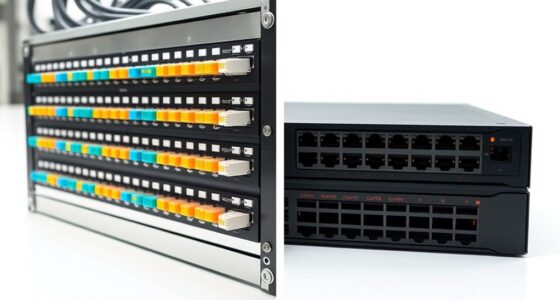In industrial networks, ensuring timely and predictable data transfer is critical for safety, automation, and efficiency. Time-Sensitive Networking (TSN) offers a way to achieve this by synchronizing device clocks and managing traffic flow tightly. As industries adopt more complex and interconnected systems, understanding how TSN transforms Ethernet into a reliable backbone becomes increasingly important. Discover how these advancements could reshape your approach to industrial communication.
Key Takeaways
- TSN ensures deterministic, real-time data transmission in industrial networks, supporting safety-critical applications.
- It synchronizes network clocks to enable precise scheduling and prioritized data flow.
- TSN transforms Ethernet into a predictable platform, reducing latency and jitter for industrial processes.
- It enhances network security and reliability by controlling data flows and preventing timing errors.
- TSN enables seamless integration of diverse data types, ensuring reliable and timely communication across industrial systems.

In modern industrial networks, guaranteeing real-time data transmission is essential for maintaining safety, efficiency, and productivity. Time-Sensitive Networking (TSN) plays a critical role in achieving this goal by providing deterministic communication over standard Ethernet networks. When you implement TSN, you enable your industrial systems to deliver data with minimal latency, ensuring that important information arrives precisely when needed. This capability is essential for applications like robotic control, safety systems, and process automation, where delays could lead to errors or hazards.
Guaranteeing real-time data transmission with TSN enhances safety, efficiency, and productivity in industrial networks.
At the core of TSN is the concept of network synchronization. By synchronizing clocks across all devices in your network, TSN guarantees that data packets are transmitted and received within predictable time frames. This synchronization isn’t just about aligning clocks; it’s about creating a shared temporal framework that allows for precise scheduling of data flows. When your devices operate on a synchronized timeline, you can prioritize critical messages, avoid collisions, and reduce jitter, all of which contribute to reliable real-time communication.
With TSN, network engineers can design and enforce traffic schedules that allocate bandwidth for time-critical data streams. This scheduling ensures that high-priority messages, such as safety signals or control commands, are transmitted without interruption or delay. You’ll notice that this approach contrasts with traditional Ethernet, which isn’t inherently deterministic and can suffer from unpredictable latency. TSN transforms Ethernet into a real-time communication platform, capable of supporting the stringent demands of industrial environments.
Moreover, TSN’s ability to provide deterministic performance means you can integrate various types of traffic—control data, video streams, sensor information—on the same network without sacrificing reliability. This multiplexing is essential as industrial systems become more interconnected and data-driven. When your network maintains tight synchronization and prioritizes real-time communication, you reduce the risk of data loss or timing errors, which could otherwise cause system failures or safety issues.
Furthermore, the adoption of TSN can help address vulnerabilities related to AI security by creating more predictable and controlled data flows, reducing the likelihood of disruptions caused by cyber threats or malicious attacks. When your network maintains tight synchronization and prioritizes real-time communication, you reduce the risk of data loss or timing errors, which could otherwise cause system failures or safety issues.
Frequently Asked Questions
How Does TSN Differ From Traditional Ethernet in Industrial Settings?
You’ll find that TSN differs from traditional Ethernet by providing deterministic communication and reducing latency, which is vital in industrial settings. Unlike standard Ethernet, TSN prioritizes time-sensitive data, ensuring it arrives on schedule. This technology manages traffic more efficiently, minimizing delays and jitter. As a result, it enables real-time control and synchronization, making industrial networks more reliable and responsive for critical applications.
What Are the Main Challenges in Implementing TSN?
You face several challenges when implementing TSN; notably, around 75% of existing hardware isn’t fully compatible, making upgrades necessary. Hardware compatibility issues can delay deployment and increase costs. Additionally, optimizing latency requires precise configuration, which is complex and demands expertise. Balancing these factors is vital to guarantee reliable, real-time communication, but the technical hurdles can be significant, requiring careful planning and investment.
How Does TSN Impact Network Security in Industrial Environments?
TSN impacts your industrial network security by reducing cybersecurity vulnerabilities through precise traffic management and synchronization. However, it also introduces new risks if not properly configured, potentially affecting data integrity. You must guarantee robust security measures like encryption and access controls, as TSN’s high-speed, deterministic nature can be exploited by cyber threats. Proper implementation helps maintain data integrity while minimizing vulnerabilities in your industrial environment.
Can TSN Integrate With Existing Industrial Protocols?
Yes, you can integrate TSN with existing industrial protocols by focusing on protocol interoperability and legacy system integration. TSN is designed to work alongside protocols like Ethernet/IP, PROFINET, and EtherCAT, enabling seamless communication. By using gateways and translation layers, you guarantee your legacy systems communicate effectively with TSN-enabled devices, facilitating smooth upgrades without overhauling your entire network infrastructure. This approach helps maintain operational continuity while enhancing performance.
What Are the Future Trends for TSN Technology Development?
Think of TSN as a river flowing into a vast ocean. Future trends involve integrating edge computing and machine learning to optimize data flow and predict network issues before they arise. This evolution will make TSN smarter, enabling real-time decision-making and enhanced reliability in industrial environments. You’ll see more adaptive, autonomous networks that seamlessly support the growing demands of Industry 4.0, pushing the boundaries of speed and precision.
Conclusion
As you implement TSN, think of it as the heartbeat of your industrial network—steady and unwavering. It guides every pulse of data like a lighthouse guiding ships through fog, ensuring safety and precision. With TSN, your system becomes a symphony of synchronized movements, where each device plays in harmony. Embrace this reliable rhythm, and you’ll navigate complex environments with confidence, knowing your network’s future is secured by a steady, unwavering pulse of certainty.









